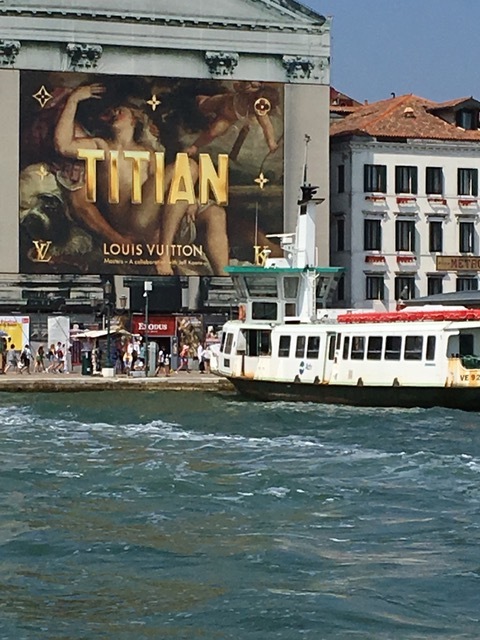Baroque Intertextuality: McArthur Binion, Koons, & Titian
November 22, 2017
by Emel Thomson
The Venice Biennale was — and is — a cultural nerve tightly bound to the fabric and waterways of the city. This year’s theme is centered on the artist’s practice: the multiplicity of approaches and the wide variety of practices. To realize a show with such a broad agenda, more than 120 artists representing 51 nations are participating. The spectator is faced with a sensory overload, a dizzying experience that is not isolated to the two main Biennale locations, but Venice in general. Art is everywhere, from balconies overlooking winding alleyways to the windows of hotels and palazzos seen from swaying vaporettos moving along the canal. Franco Berardi’s term “semiotic inflation” is the unwritten theme of the Biennale and Venice. Through the lens of Franco Berardi, I will focus on the works of McArthur Binion and also the work of Titian and Jeff Koons.
The Venetian artist, Titian, created the painting Mars,Venus and Cupid in 1546; the painting is housed in the Guggenheim Bilbao in Spain. Titian returns to Venice 471 years later to market his painting just in time for the Biennale. A reproduction of the painting can be viewed on the façade of a building facing the Grand Canal near Piazza San Marco in Venice.

The Paris-based fashion house Louis Vuitton has teamed up with artist Jeff Koons to appropriate iconic works of art from the renaissance period for their handbag collection that ranges from $1,000 to $4,000. The Titian/Vuitton handbag, with a capitalist touch, is available to a select group who can pay the high price for a bag that borrows from the renaissance, contemporary art, and pop culture (Andy Warhol comes to mind). The intertextual relationship creates a crisis of semiotic reference. Vuitton is exploiting the denotative relation between sign and meaning, and the value of the bag is established on the basis of a simulation in a relation that does not follow any rules. Titian’s painting has been robbed from its place in the art world and takes central place as a brand in the world of the commodity.
The Vuitton ad intertextualizes art and fashion with a painting created in 1546 reappearing in a present-day version of a fresco: an advertising billboard. The project also links different cultures and industries: a contemporary artist based in New York, a fashion house based in Paris, the Balboa museum in Spain, and a high Renaissance artist from Venice, to name a few. The semiotic production can be considered as a resurgence of the Baroque spirit with a direct relationship to the city’s history as an early version of globalized markets.
The DNA paintings by McArthur Binion appear as grids reminiscent of abstract style of modernist paintings. From a distance the paintings appear devoid of expression. On close inspection the space between the lines expose handwriting and photocopies of the artist’s birth certificate.
%252Bby%252BMcArthur%252BBinion%252C%252B2015.jpeg)
The paintings juxtapose the personal with the historical and allude to the artist’s experiences as an African American artist and picking cotton as a child. The artist channels the historic and personal through the idea of DNA. Binion alters the acronym to refer to “distinct neurological advancement, or Detroit Negro Artist.”
I was drawn to the order of the grid that was repeated on several canvases. As I moved in closer I saw the handwriting that layered a personal history. The juxtaposition of personal with the abstract is a simulation between appearances, a term Franco “Bifo” Berardi discussed in his lecture. The paintings reflect the ambiguity of a person. Bifo discussed ambiguity in relation to the Spanish inquisition and the investigation of the ambiguity of a person, a fate that led to racism and ethnic cleansing.
Binion’s paintings offer the viewer the possibility of finding lines of interpretation, a common ground of identification in a place of public discourse. The adjoining rooms offer a multiplicity of perspectives that at times appear as too many semiotic signs, an inflation of art that offers many perspectives but with less lines of possible interpretations. Chaos invades the space of public discourse at the Biennale with an overload of art that occasionally reflects the generalized theme of an artist’s practice.
